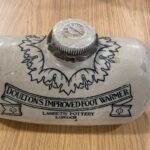One of the first things I learned was how to handle objects. Gloves were essential and they had to be powder free and in this case we used Nitrile gloves.
Then we had to handle the object. Always lift the object from the base to give it as much support as possible and give particular care when unwrapping the object.
Never use the handle of an object because the handle is usually a weak point. This is more difficult than you think because we instinctively go for a handle to lift an object.
Now comes the process of identifying the object. Thank goodness for google, google lens and eBay for cross referencing. What did people do before the internet?
The identified object has to be relevant to Crawley. This often took up a large amount of time especially if the object was pretty or a fine example. We regularly had differing opinions here and sometimes we would need to do a bit more research of the object to determine its relevance to Crawley.
So if the object was deemed relevant it was given an official collections number and added to the MODES database. If it didn’t get in the collection the object had to be discussed again to see if it would go into the handling collection or set dressing or put into dispersal!
Dispersal is the comfortable word museums used instead of destroying it or throwing it away. We could also offer it to other museums.
I also learned the museum had an endless collection of milk bottles and numerous typewriters and sewing machines.
It was amazing to see what was behind the scenes.
by Chris





